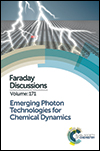Approaches to time-resolved diffraction using an XFEL
Abstract
We describe several schemes for time-resolved imaging of molecular motion using a free-electron laser (XFEL), in response to the many challenges and opportunities which XFEL radiation has created for accurate time-resolved measurement of structure. For pump–probe experiments using crystals, the problem of recording full Bragg reflections (not partials) in each shot arises. Two solutions, the use of the large bandwith which necesarily results from using attosecond pulses, and the use the coherent convergent beam mode are suggested. We also show that with attosecond recording times shorter than the temporal coherence time, Bragg reflections excited by different wavelengths from different reflections can interfere, providing structure factor phase information. For slower processes, a mixing jet sample-delivery device is described to allow snapshot solution scattering during molecular reactions on the microsecond scale. For optically excited membrane proteins, we suggest the use of the lipid cubic phase sample delivery device operating at atmospheric pressure. The use of two-color and split-and-delay schemes is suggested for improved accuracy in the Monte-Carlo method of serial femtosecond crystallography (SFX).
- This article is part of the themed collection: Emerging Photon Technologies for Chemical Dynamics

 Please wait while we load your content...
Please wait while we load your content...